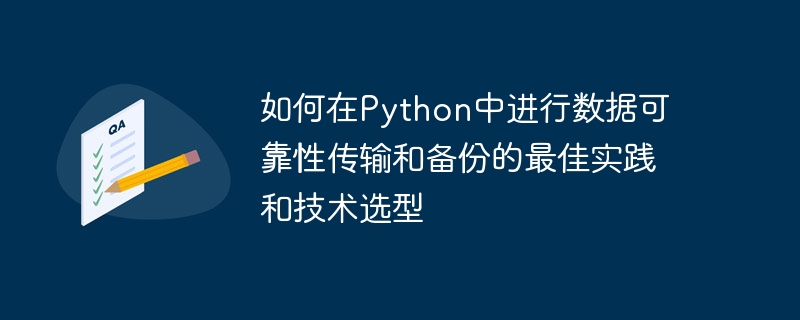

How to perform best practices and technology selection for reliable data transmission and backup in Python
Introduction:
In the modern information age, data reliability Sexual transfer and backup are very important. Whether you're managing a large database system or processing user-uploaded files, you need to ensure that data isn't lost or corrupted in transit and that there are backups available for recovery if the unexpected happens. This article will introduce the best practices and technology selection for reliable data transmission and backup in Python, and provide some specific code examples.
1. Reliability of data transmission
During the data transmission process, we face a variety of risks, such as network interruptions, transmission errors, etc. In order to ensure the integrity and reliability of data, we can adopt the following practices and technology selections:
import socket
# 创建TCP连接
def create_connection(address):
sock = socket.socket(socket.AF_INET, socket.SOCK_STREAM)
sock.connect(address)
return sock
# 发送数据
def send_data(sock, data):
sock.sendall(data.encode())
# 接收数据
def receive_data(sock, buffer_size=1024):
data = sock.recv(buffer_size)
return data.decode()
# 关闭连接
def close_connection(sock):
sock.close()import hashlib
# 计算数据的哈希值
def calculate_hash(data):
md5 = hashlib.md5()
md5.update(data.encode())
return md5.hexdigest()
# 校验数据的完整性
def verify_data(data, hash_value):
if calculate_hash(data) == hash_value:
return True
else:
return Falseimport time
# 发送数据,并确认接收
def send_data(sock, data):
while True:
sock.sendall(data.encode())
response = sock.recv(1024).decode()
if response == 'ACK':
break
time.sleep(1)2. Best practices for data backup
Data backup is a preventive measure to ensure recovery in the event of data loss or damage . In Python, we can adopt the following best practices:
from apscheduler.schedulers.background import BackgroundScheduler
# 定义一个定期备份任务
def backup_data():
# 备份数据的代码
# 创建调度器
scheduler = BackgroundScheduler()
# 添加定期备份任务
scheduler.add_job(backup_data, 'interval', hours=24)
# 启动调度器
scheduler.start()import boto3
# 创建S3客户端
client = boto3.client('s3')
# 上传备份文件到S3
def upload_file(bucket_name, file_path):
client.upload_file(file_path, bucket_name, file_path.split('/')[-1])
# 下载备份文件
def download_file(bucket_name, file_name, save_path):
client.download_file(bucket_name, file_name, save_path)
# 删除备份文件
def delete_file(bucket_name, file_name):
client.delete_object(Bucket=bucket_name, Key=file_name)import shutil
# 执行增量备份
def incremental_backup(source_folder, backup_folder):
shutil.copytree(source_folder, backup_folder, copy_function=shutil.copy2)Conclusion:
With correct practice and appropriate technology selection, we can achieve reliable transmission and backup of data in Python. This article introduces the practice of using TCP protocol for data transmission, implementing data verification mechanism, adding retransmission mechanism, etc., as well as the best practices of using regular backup, cloud storage backup and incremental backup. These methods can provide you with reliable data transfer and backup solutions to protect your data from unexpected losses.
The above is the detailed content of Best practices and technology selection for reliable data transmission and backup in Python. For more information, please follow other related articles on the PHP Chinese website!




